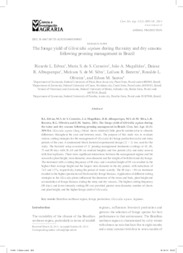The forage yield of Gliricidia sepium during the rainy and dry seasons following pruning management in Brazil.
The forage yield of Gliricidia sepium during the rainy and dry seasons following pruning management in Brazil.
Author(s): EDVAN, R. L.; CARNEIRO, M. S. de S.; MAGALHAES, J. A.; ALBUQUERQUE, D. R.; SILVA, M. S. de M.; BEZERRA, L. R.; OLIVEIRA, R. L.; SANTOS, E. M.
Summary: Gliricidia sepium (Jacq.) Steud. shows relatively little growth variation due to climatic differences throughout the year and between years. The purpose of this study was to evaluate various cutting strategies for the management of Gliricidia for forage production in dry and rainy periods of the year. A randomized-block factorial experimental design (12 × 2) was used for the study. The factorial setup consisted of 12 pruning management treatments (cuttings at 45, 60, 75 and 90 days with 30, 60 and 90 cm residual heights) and two periods (dry and rainy season) with four replicates. There were significant interactions between the management regime and the season for plant height, stem diameter, stem diameter and the weight of both fresh and dry forage. The treatment with a cutting frequency of 90 days and a residual height of 90 cm resulted in the highest final average height and the largest stem diameter in the dry period, with reductions of 7.65 and 1.5%, respectively, during the period of water scarcity. The 90 days × 90 cm treatment resulted in the highest production of fresh and dry forage biomass. Application of different cutting strategies to the Gliricidia plants influenced the diameters of the stems and buds, plant height and accumulation of forage biomass during the rainy and dry seasons. The highest cutting frequency (90 days) and lower intensity cutting (90 cm) provided greater stem diameter, number of shoots and plant height, and the higher forage yield of Gliricidia.
Publication year: 2014
Types of publication: Journal article
Unit: Embrapa Mid-North
Observation
Some of Embrapa's publications are published as ePub files. To read them, use or download one of the following free software options to your computer or mobile device. Android: Google Play Books; IOS: iBooks; Windows and Linux: Calibre.
Access other publications
Access the Agricultural Research Database (BDPA) to consult Embrapa's full library collection and records.
Visit Embrapa Bookstore to purchase books and other publications sold by Embrapa.

